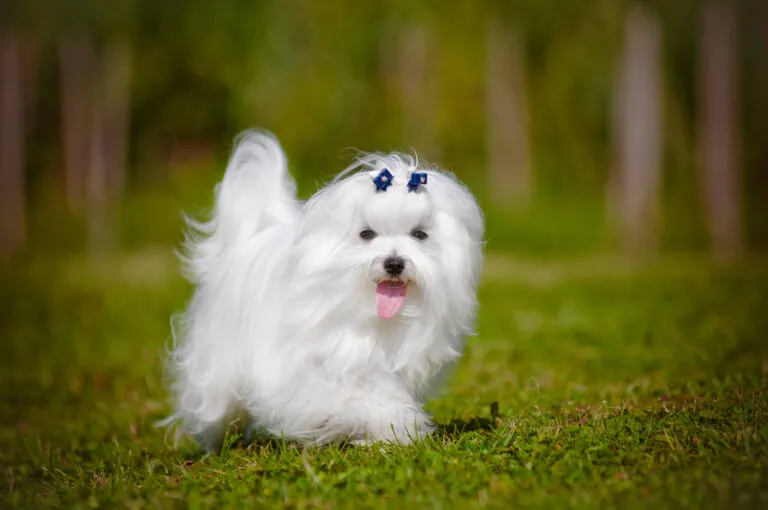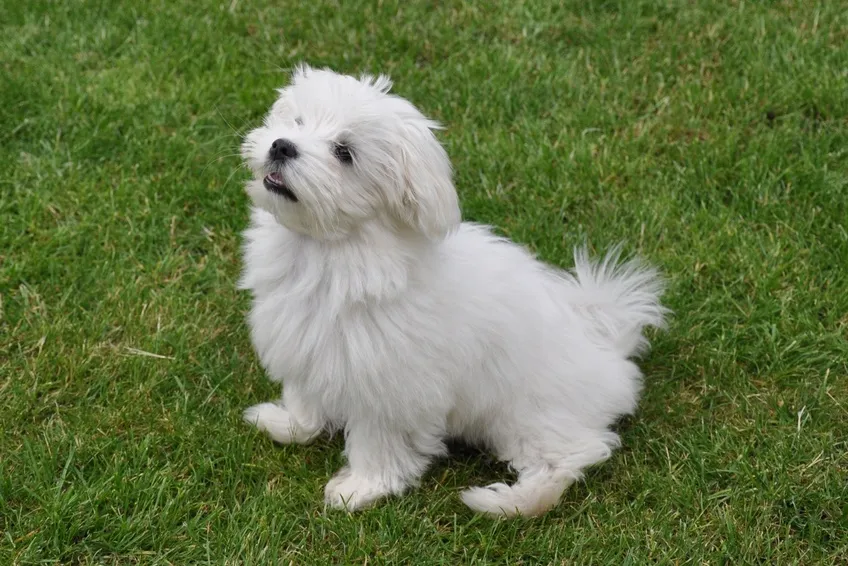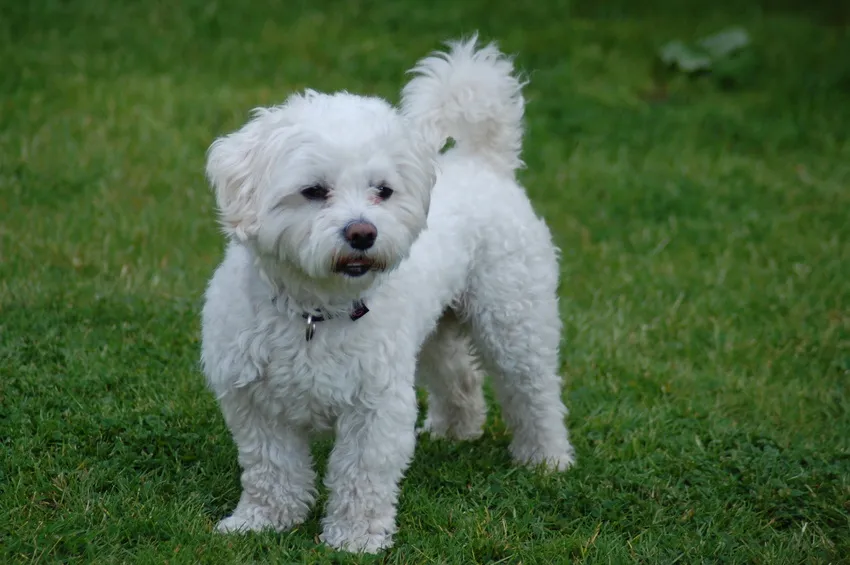Medium Size Poodle
Intelligent and lively, small Maltese dogs delight many animal lovers. They make excellent companions for people who like to have their dog close by at all times and take joy in grooming the snow-white fur.

© otsphoto / stock.adobe.com
The little Maltese is a popular family dog.
With dark button eyes, a black nose and pure white fur, the Maltese melts the heart of many dog lovers. It’s guaranteed to get attention: despite a shoulder height of only 21-25cm and reaching a maximum weight of 4kg, this small breed immediately catches the eye thanks to their joyful aura. The silky fur doesn’t have an undercoat and reaches down to the ground. However, the Maltese’s well-maintained appearance requires extensive grooming from its owner. Physically, this breed is very similar to its close relatives, the other Bichons or lapdogs. Many non-experts mistake it for the equally white Coton de Tuléar in particular. However, the Maltese is smaller and has smooth fur.
Maltese dogs compensate for their small size with their positive, lively aura. They are smart, good-natured, playful and enjoy learning new tricks. Although they are vigilant, they don’t tend to yap. It takes them time to warm to strangers – they are devoted to their caregiver, who they always want around. Being alone is difficult for this breed, which has been bred for centuries to delight people with its company. Hence, you should never leave these affectionate dogs alone for long periods. They are easy-going companions: be it playing, trips away or simply lazing around together, the Maltese is always in a good mood. The main thing for it is being together with its loved ones.
 © Richard Kadow / stock.adobe.com
© Richard Kadow / stock.adobe.com
Training these docile little dogs poses no difficulties even for beginners. The Maltese is willing to learn but sensitive too – avoid any abruptness when handling these sensitive dogs. Don’t mollycoddle your Maltese when it discovers new things – these small dogs are much more than mere lapdogs. Of course, the Maltese too needs consistent training in order to learn what is acceptable and what isn’t – don’t fall for begging looks and make no exceptions, for instance, if it isn’t allowed in your bed – even if it is hard to resist its sugar-sweet gaze. Once you give in, you will have to start all over again.
The roots of this breed can be traced back to antiquity: a theory indicates that the Maltese’s ancestors came from Egypt, from where they were then taken further afield by merchants. Archaeologists discovered small statues of dogs resembling the present-day Maltese in the tomb of the famous pharaoh Ramses II. Illustrations on vases around 700 years later show a small dog with the word “Melitae” alongside. However, it is quite evident that little light can be shed on the origin of the name. For a long time, the assumption was that this merely referred to the island of Malta off the coast of Sicily or the Dalmatian island of Mljet, although nowadays it is presumed that the name originates from the Semitic word “màlat” meaning port used in many place names.
It is certain that the ancestors of these small dogs were already well-known in antiquity and popular society dogs. Over the course of the centuries, these attractive mini dogs were sought-after companions of aristocratic ladies and noblemen and kings and queens. For instance, Queen Victoria of Great Britain and the French queens Marie Antoinette and Joséphine Bonaparte can be counted amongst Maltese owners. The Maltese is a popular dog in the present day too and can also live happily in cities.
Like with many small dogs, this breed is also prone to luxating patella, a painful dislocation of the knee cap. The best precaution against this is to avoid your dog being overweight and giving it regular exercise, because this strengthens the stabilising muscles surrounding the knee. In addition, they have a tendency to develop diabetes as well as problems with the tear ducts. Keep their eyes free of hairs to prevent this, because hairs often end up in the eyes and cause irritation. You’re best off cleaning your companion’s eyes on a daily basis with a special eye cleanser for dogs. The abundant Maltese coat also needs daily brushing in order to keep it healthy, otherwise it may become matted. A Maltese in good health can reach 14 to 16 years of age.
It’s even more crucial to avoid obesity with a dog weighing a maximum of 4kg according to the standard. Consider that 2kg of excess weight is equivalent to a human weighing over 100kg rather than an ideal weight of 70kg! The risk of joint and heart problems and diabetes increases for overweight Maltese dogs. The manufacturer’s indications on the daily portion allowance are merely guidelines that you should adapt to your dog. Weigh adult Maltese dogs regularly in order to intervene if necessary. When your dog first enters your home, you’re better off giving it the food it is already familiar with. Changes to the food should be made carefully, for instance, by mixing a bit more of the new food into the usual one day by day. This helps you avoid hypersensitivity reactions like diarrhoea or vomiting.
Regardless of whether you choose wet or dry food, the food should have a high quantity of meat. A diet with a high-quality food without cheap filler ingredients and tailored to the nutritional requirements of your dog is reflected in shiny fur, healthy skin and easy digestion. Make sure treats are of good quality: along with dental care snacks with additional benefits, freeze-dried grain-free snacks are ideally suited as little occasional rewards. Drinking water should be readily available to your Maltese at all times.
Even very small dogs can have a lot of fur – the Maltese is living proof of this! Grooming this breed is demanding and should not be underestimated. Dog lovers who find grooming a necessary evil should ideally not opt for a Maltese.
After every walk, you should feel your Maltese to remove twigs or leaves that have got stuck in the coat. The long, silky fur requires daily brushing, since it tends to become matted. In addition, you should give your Maltese a bath at least twice a month: get it used to this ritual when it is still a puppy and use a mild dog shampoo for long or white fur. Beforehand, thoroughly brush your dog’s coat. Use lukewarm water, lovingly massage in the shampoo and thoroughly rinse the fur. A second rinse with conditioner gives the fur extra care. Last but not least, gently squeeze the water out of the fur and carefully use a hairdryer on your little dog, because a wet Maltese can soon develop a cold.
If necessary, treat the ears with an ear cleanser and keep the eyes free of hairs, as well as regularly cleaning them with an eye cleanser. Frequently check the claws of your Maltese too – they often end up too long especially in old age and need to be cut with claw clippers.
Shorten the waiting time before your dog enters your home by choosing practical basic equipment. Create a comfortable sleeping spot – you can choose between numerous dog baskets and blankets. A collar or harness and lead are fundamental, as well as food and water bowls. Consider too how you wish to transport your dog – there are many possible carry cases. Your dog also requires grooming accessories: along with a soft brush, a wide-tooth comb is suitable for preparatory work. You should also have special dog scissors to hand in order to trim the fur in some areas. Get a mild dog shampoo and conditioner – if you are taking on a puppy, get a puppy shampoo, which you can later change for a dog shampoo for long or white fur. Ear and eye cleansers are also useful with this breed. Clippers and tick tweezers complete the grooming equipment.
 © Senwyn / stock.adobe.com
© Senwyn / stock.adobe.com
Maltese dogs are little explorers that love discovering and sniffing around to their heart’s content. They take great joy in playing. Find a good balance between physical and mental stimulation, and plan in time for naps and to laze around together. Your Maltese will love having lots of toys – for instance, tug toys, balls and frisbees or intelligence toys. Clickers are also a great pastime for the clever Maltese, which loves to learn tricks, and helps you strengthen your connection. Dog dancing is another good opportunity to train body and mind at the same time. Your little whirlwind may even enjoy agility! Always take occasional breaks so that your dog doesn’t end up too exhausted with its short legs. You should only take challenging steps in dog sport when your Maltese is fully grown to avoid damaging the locomotor system.
Interested parties should definitely enjoy stroking, brushing and going for walks. These affectionate dogs don’t like to be alone for a long time and therefore need people who can spend time with them often and for long periods. The breed is well suited to pensioners who like to be out and about outdoors, though also for employees who can take their dog to work. They form a very close attachment to their caregiver and are also excellent travel companions due to their size. A Maltese is happy living in a city apartment too if it gets sufficient exercise. Although it loves frolicking around and playing, it doesn’t need any intense sporting activity. The breed is also suitable for first-time dog owners who are willing to learn.
If you’ve fallen for this breed, you should only buy a puppy from a responsible breeder who brings plenty of expertise regarding character, typicality and health to the breeding process. When it comes to “chance litters” or even breeders focused on quantity who primarily breed for financial gain without a pedigree certificate or belonging to an association, you have no guarantee whatsoever that they offer genuine Maltese dogs. The health and character can be in jeopardy, since such dogs are often in poor health and not well socialised. In short, investing time and money in looking for a good breeder is definitely worth it – after all, you aren’t looking for a bargain but a companion for many years!
When visiting the breeder’s home, you will ideally be able to meet the parent animals too and see how the puppies are reared. All should appear healthy and even-tempered. The breeder will happily provide you information on preliminary healthcare examinations and advise you on the puppy that could be the best fit for you. They are also a point of contact regarding diet and grooming and will certainly have a few tips for you on these subjects. Your little Maltese will enter your home at the age of eight weeks at the earliest. It will bring with it a vaccination record as well as a pedigree certificate. Definitely stick to the booster appointments in order to guarantee immunisation.
If you’re looking for an adult dog, you can be very successful in local animal shelters, which will certainly offer Maltese dogs or other Bichons occasionally. If not, you will strike it rich online, since there are always Maltese dogs looking for a new home – be it because the previous owner has underestimated grooming demands or due to separations or bereavements. The cuddly Maltese suffers greatly without human affection and will be delighted to have a new home!
We wish you a wonderful time with your cuddly cheerful little soul!
Fans of the Bearded Collie agree that those who aren't familiar with this dog breed simply have to get acquainted with it. And those who have experienced how a Bearded Collie bolts across meadows with its flowing fur, how it rolls around full of energy and joy and how it attentively and observantly takes into account its owners wishes become simply addicted to this original dog breed and its unique charm.
The Goldendoodle isn't a breed, but a pairing between Golden Retrievers and Medium or Standard Poodles. Marketed as a low-maintenance dog for allergy sufferers, this hybrid is enjoying increasing popularity amongst dog lovers, similar to the Labradoodle.